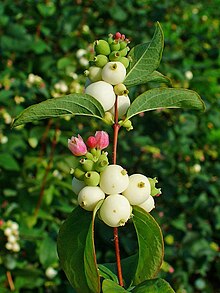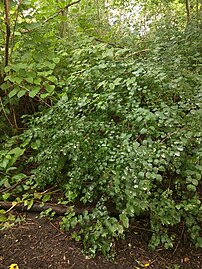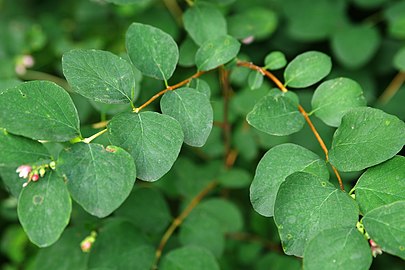Symphoricarpos albus
| Symphoricarpos albus | |
|---|---|

| |
| Scientific classification | |
| Kingdom: | Plantae |
| Clade: | Tracheophytes |
| Clade: | Angiosperms |
| Clade: | Eudicots |
| Clade: | Asterids |
| Order: | Dipsacales |
| Family: | Caprifoliaceae |
| Genus: | Symphoricarpos |
| Species: | S. albus
|
| Binomial name | |
| Symphoricarpos albus | |
| Synonyms[2] | |
| |
Symphoricarpos albus is a species of flowering plant in the honeysuckle family known by the common name common snowberry.[3] Native to North America, it is browsed by some animals and planted for ornamental and ecological purposes, but is poisonous to humans.
Description
[edit]S. albus is an erect, deciduous shrub, producing a stiff, branching main stem and often several smaller shoots from a rhizome. It can spread and colonize an area to form a dense thicket.[4] It reaches 1–2 metres (3+1⁄2–6+1⁄2 feet) in maximum height. The leaves are oppositely arranged on the spreading branches. They are generally oval, differing in size and shape, and up to 5 centimetres (2 inches) long, or slightly larger on the shoots. The inflorescence is a raceme of up to 16 flowers. Each flower has a small, five-toothed calyx of sepals. The bell-shaped, rounded corolla is about 0.5 cm (1⁄4 in) long and bright pink in color. It has pointed lobes at the mouth and the inside is filled with white hairs. The fruit is a fleshy white berry-like drupe about 1 cm wide which contains two seeds. The plant sometimes reproduces via seed but it is primarily vegetative, reproducing by sprouting from its spreading rhizome.[4] Birds disperse the seeds after they eat the fruit.[4]
Varieties
[edit]There are two varieties:
- S. albus var. albus, native to eastern North America
- S. albus var. laevigatus, native to the Pacific coast. It is a larger shrub, up to 2 m (6+1⁄2 ft) tall, with slightly larger fruit. Some botanists treat it as a distinct species, Symphoricarpos rivularis.
Distribution and habitat
[edit]S. albus occurs across much of Canada and the northern and western United States.[5][6]
It grows in shady and moist mountain and forest habitat, in woodlands and on floodplains and riverbanks. It can grow in a wide variety of habitat types.[4] It is naturalized in parts of Britain, where it has been planted as an ornamental and cover for game animals.[7]
Ecology
[edit]This shrub is an important food source for a number of animals, including bighorn sheep, white-tailed deer, and grizzly bears.[4] Livestock such as cattle and sheep readily browse it.[4] Many birds and small mammals use it for food and cover.[4] Pocket gophers dig burrows underneath it during the winter.[4]
Toxicity
[edit]The fruit and shrub are poisonous to humans, causing vomiting.[8]
Uses
[edit]Native Americans used the plant as medicine, soap, sometimes for food, and the wood was good for arrow shafts.[4] In Russia, the berries are crushed in the hands and rubbed about for a soothing folk-remedy hand lotion.[citation needed]
This shrub is used for erosion control in riparian areas, and it is planted in ecological restoration projects on disturbed sites such as abandoned mines.[4] Its white fruits and blue-green foliage made it popular as an ornamental plant[4] planted around old houses of the 1890s through the 1920s like with the Vanhoutte Spirea or Bridalwreath. It is still sold by some large diverse conventional nurseries and native plant nurseries, and occasionally found in modern landscapes. It grows in full sun to full light shade and a well-drained soil that is slightly acid to well alkaline, pH range of about 6.0 to 8.5. it is easy to transplant with its fibrous, shallow root system. It fares well in U.S. Department of Agriculture hardiness zones of 2 to 7.
References
[edit]- ^ NatureServe (2024). "Symphoricarpos albus". Arlington, Virginia. Retrieved 13 January 2024.
- ^ "Symphoricarpos albus". World Checklist of Selected Plant Families. Royal Botanic Gardens, Kew – via The Plant List. Note that this website has been superseded by World Flora Online
- ^ USDA, NRCS (n.d.). "Symphoricarpos albus". The PLANTS Database (plants.usda.gov). Greensboro, North Carolina: National Plant Data Team. Retrieved 4 December 2015.
- ^ a b c d e f g h i j k McWilliams, Jack (2000). "Symphoricarpos albus". Fire Effects Information System (FEIS). US Department of Agriculture (USDA), Forest Service (USFS), Rocky Mountain Research Station, Fire Sciences Laboratory.
- ^ "Symphoricarpos albus". County-level distribution map from the North American Plant Atlas (NAPA). Biota of North America Program (BONAP). 2014.
- ^ Jones, George Neville (1940). "A monograph of the genus Symphoricarpos". Journal of the Arnold Arboretum. 21 (2): 214–218.
- ^ Gilbert, O. L. (1995). "Symphoricarpos albus (L.) S. F. Blake (S. rivularis Suksd., S. racemosus Michaux)". Journal of Ecology. 83 (1): 159–66. doi:10.2307/2261160. JSTOR 2261160.
- ^ Lewis, Walter H. (1979-12-14). "Snowberry (Symphoricarpos) Poisoning in Children". JAMA: The Journal of the American Medical Association. 242 (24): 2663. doi:10.1001/jama.1979.03300240009006. ISSN 0098-7484. PMID 501855.






